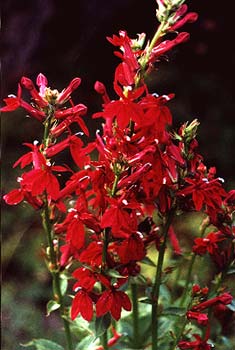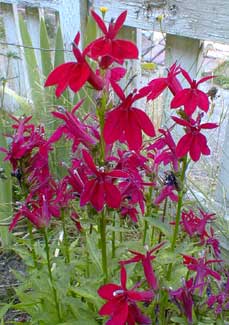
'Fan Burgundy'
Cardinal Flower
"Then the green grass sprouted,
And the little red flowers blossomed."
from "The Creation"
by James Weldon Johnson
1871-1938
by James Weldon Johnson
1871-1938
Lobelia x speciosa 'Fan Burgundy' is suited to the bog garden, but equally adaptable to well-drained persistently moist soil. Marginally hardy, it will be a rewarding perennial if it never experiences drought. It becomes increasingly a shade plant the farther south it is grown, but on Puget Sound it likes full sun, or at least full morning sun.
It usually grows easily to three feet tall, with flower spikes that can be taller, though ours has been two feet tall year after year.
The flowers last from July through September or until first frost, & are at their height of glory late in July through August.
"Speciosa" is a hybrid name for cultivars derived from L. fulgens, L. cardinalis & L. siphilitica. Collectively these cultivars are sometimes called "Fan hybrids."
 The velvety tubulor florets of 'Fan Burgundy' are a color most appealing to hummingbirds. They can be more tender than the species L. cardinalis. In zones with harsher winters than ours, the hybrids may prove to be annuals, but even so may self-seed & naturalize in a moist garden.
The velvety tubulor florets of 'Fan Burgundy' are a color most appealing to hummingbirds. They can be more tender than the species L. cardinalis. In zones with harsher winters than ours, the hybrids may prove to be annuals, but even so may self-seed & naturalize in a moist garden.Though often described as a short-lived perennial, ours after four years had not yet shown signs of wearing out, though it did eventually vanish after an unexpectedly harsh winter. In our temperate area, the leaves do not invariably die entirely back in winter, & any mulching must be done carefully so as not to smother the basal leaves.
Cardinal Flowers are native to the Atlantic side of North America in Canada & the United States. The genus is named for Mathias de l'Obel (1538-1616), physician to William of Orange; & later, in England, chief botanist under James I. This naming honor was bestowed on Dr. de l'Obel by a French monk & naturalist, Charles Plumier.
Native American traditional medicines included the leaves & seeds of cardinal flowers for the treatment of severe illnesses. Its chemical compounds, however, are toxic, & its use has been known commonly to cause difficulty in breathing, vomiting spells, mental confusion, sweats, tremors, convulsions, coma, & death.
Its alkaloids, including lobeline, have neurological effects on the body not dissimilar from nicotine, hence the folk names Wild Tobacco or Indian Tobacco. Lobelia was formerly used in stop-smoking products as a nicotine substitute, but the FDA banned its use for treating tobacco addiction specifically because all statements that it might cure smokers were abject falsehoods.
Additional folk-names for various species of lobelia refer less to its purported medicinal values than to its side-effects: Pukeweed, Vomit Wort, Asthma Weed, Gagroot, or Emetic Herb.
It is especially dangerous for children, the elderly, pregnant women, & anyone who suffers from lung disease, asthma, epilepsy, high blood pressure, or a heart condition. This hasn't kept purveyors of herbal remedies from selling it without warnings as a food supplement, nor kept them from including lobelia in "mixes" of herbs under such a variety of names that users often don't really know what is in the pills they are popping or the extracts they are swilling.
In 2004, Consumer's Report included lobelia among the "dirty dozen" most dangerous herbal supplements either wittingly or unwittingly injested by people enamored of alternative medicines. Though sold only as "diet supplements" because US law does not permit unproven health claims to be included directly on the packaging, people buy them for all sorts of medicinal purposes, self-prescribed more often than not on the basis of rumors of imagined values & misleading promotional literature.
Yet species of lobelia are more apt than most herbal remedies to have authentic medicinal values. Under a a qualified physician's care, lobelia may have a realistic value in treatment of respiratory illnesses. But its use willynilly without competent, professional medical consultation, may worsen respiratory illness, in addition to risking other side-effects.
Herbs that are actually potent also have serious & adverse side-effects. The public's habit of self-prescription seems to fall into two categories: 1) Herbs with no proven benefit, but which also cause no direct adverse effects; & 2) random use of potent herbs with alkaloids that may well have medicinal effects, but by their very potency also have dangerous side effects.
The little-regulated industry, advertising itself as though concerned with good health, is second only to the tobacco industry in its willingness to endanger lives for sake of profits.
See also Lobelia x speciosa 'Compliment Deep Red' page for further discussion.